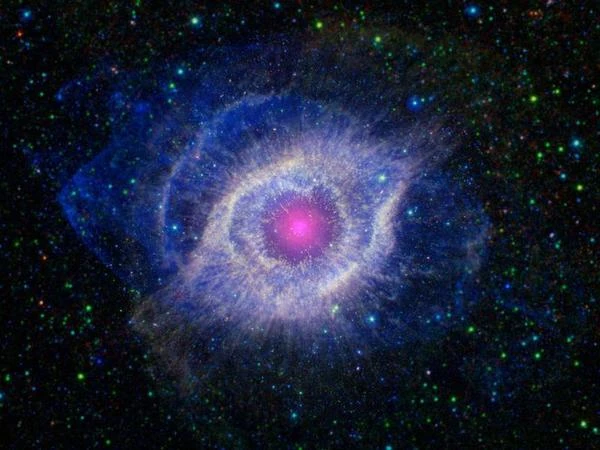
The Helix Nebula (NGC 7293) is a planetary nebula located about 655 light-years away in the constellation Aquarius. It represents the final stage of a star similar to our Sun. After exhausting its hydrogen and helium, the star expels its outer layers into space, creating an expanding bubble. At its center remains a hot, dense core: a white dwarf with a temperature exceeding 100,000 K.
This process illustrates the transition of a stable star into a condensed form where electron degeneracy pressure balances gravity. The ultraviolet luminosity of the stellar core ionizes the surrounding gas, producing the characteristic glow observed in the nebula.
The nebula has a complex morphology composed of an inner disk, an outer halo, and filamentous structures called *cometary knots*. These gaseous condensations, hundreds of astronomical units long, move at speeds of 20 to 30 km·s\(^{-1}\).
Infrared observations from the *Spitzer* telescope revealed the presence of dust and molecules in the cooler regions, while optical spectra show strong emissions of hydrogen Hα, oxygen [O III], and nitrogen [N II] lines. These lines trace the temperature and density gradients of the plasma. The dynamics are governed by the equations of magnetohydrodynamics (MHD), where pressure forces, radiation, and magnetic fields interact in a coupled manner.
In about 5 billion years, the Sun will undergo a similar fate. It will transform into a *red giant*, lose its outer envelope, and become a planetary nebula comparable to the Helix Nebula. Stellar models show that the initial mass determines the final size of the nebula and the mass of the residual white dwarf. Thus, the Helix Nebula offers a window into our own cosmic future.
Spectroscopic data reveal relative abundances of helium, oxygen, nitrogen, and neon. The proportion of these elements provides information about the internal nuclear reactions that occurred before the ejection of the outer layers. These measurements also allow estimating the expansion speed \(v \approx 32 \, \mathrm{km·s^{-1}}\) and the total mass of ejected gas \(M_g \approx 0.3 \, M_\odot\).
Discovered in the early 19th century by the German astronomer Karl Ludwig Harding (1765-1834), the Helix Nebula was one of the first planetary nebulae identified. Its nickname "Eye of God" comes from its annular shape as seen from Earth, evoking a cosmic pupil observing the sky.
Modern analyses, particularly with the instruments of the James Webb Space Telescope (JWST), offer unprecedented resolution in the infrared. They reveal the three-dimensional distribution of gas and help better understand the interaction mechanisms between stellar wind and the interstellar medium.
| Characteristic | Observed Value | Unit | Instrument / Source |
|---|---|---|---|
| Distance | 655 ± 20 | light-years | Gaia DR3 (ESA, 2023) |
| Apparent Diameter | 16.8 | arcminutes | Hubble Space Telescope |
| Expansion Speed | 32 | km·s\(^{-1}\) | Kitt Peak Observatory |
| Ejected Mass | 0.3 | \(M_\odot\) | Post-AGB Stellar Model |
| Central Temperature | 120,000 | K | Spitzer / JWST (2024) |
Source: ESA / Hubble Heritage Team, NASA / JWST and VizieR Catalogue (CDS, Strasbourg).
N.B.:
The Helix Nebula offers a representative example of the stellar life cycle of low-mass stars (≤ 8 \(M_\odot\)). These phenomena contribute to the chemical enrichment of the interstellar medium and the recycling of matter in the Galaxy.